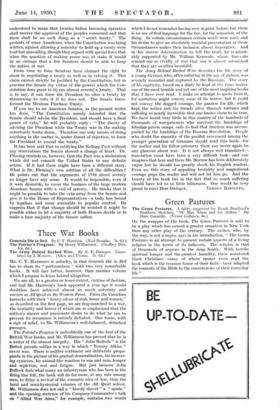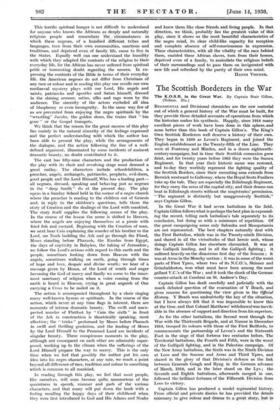Green Pastures
The Green Pastures. A fable, suggested by Roark Bradford's Southern Sketches, " 01' Man Adam and his chillun." By Marc Connelly. (Victor Gollancz. 6s.) Ox the wrapper of the book, The Green Pastures is said to be a play which has caused a greater sensation in New York than any other play of the century. The author, who, by the way, is not a negro, says in his introduction, " The Green Pastures is an attempt to present certain aspects of a living religion in the terms of its believers. The religion is that of thousands of negroes in the deep South. With terrific spiritual hunger and the greatest humility, these untutored black Christians—many of whom cannot even read the book which is the treasure house of their faith—have adapted the contents of the Bible to the consistencies of their everyday life." This terrific spiritual hunger is not difficult to understand for anyone who knows the Africans as deeply and naturally religious people and remembers the - circumstances in which these negroes, of a hundred different, trihes and languages, torn from their own communities, sanctions and traditions, and deprived even,_,of family life, came to live in the States. Equally well can one understand the humility with which they adapted the contents of the religion to their everyday life, for the African has never suffered from spiritual pride or tormenting doubt regarding the unseen. In ex- pressing the contents of the Bible in terms of their everyday life, the American negroes do not diffei from Christians of any race or colour and in reading this play one recalls our own mediaeval mystery plays with our Lord, His angels and saints, patriarchs and apostles and Satan himself, dressed in the shining armour, satins, silks and rags worn by the audience. The sincerity of the actors excluded all idea of blasphemy or even incongruity. In the same way few of us are prevented from enjoying the negro spirituals by the "wrestling" Jacobs, the golden shoes, the trains that " bin gone " or the Gospel trumpets.
We think that the reason for the great success of this play lies mainly in the natural sincerity of the feelings expressed and the perfect understanding with which the author has been able to present the play, while the arrangements of the dialogue, and the action following the line of a well- defined argument, illuminated by some incidents of eminent dramatic beauty, no doubt contributed to it._ The cast has fifty-nine characters and the production of the play with its choir and revolving stage must demand a great outlay. The characters include schoolchildren, a preacher, angels, archangels, patriarchs, prophets, evil-doers, good people and the Lord Himself, Who has a leading part— all negroes, dressed, speaking and behaving just as negroes in the " deep South " do at the present day. The play opens in a Sunday School held in the corner of a negro church where the preacher is reading to the children out of Genesis and, in reply to the children's questions, tells them the story of Creation and the dealings of the Lord with mankind. The story itself supplies the following scenes of the play. In the course of the lesson the scene is shifted to Heaven, where the angels are enjoying themselves at a picnic with fried fish and custard. Beginning with the Creation of man, we next hear Cain explaining the murder of his brother to the Lord, see Noah building the Ark and go through the Flood, Moses standing before Pharaoh, the Exodus from Egypt, the days of captivity in Babylon, the taking of Jerusalem ; we follow the Lord's actions with regard to this earth and the people, sometimes looking down from Heaven with the angels, sometimes walking on earth, going through times of hope and love, despair and divine wrath; we hear of a message given by Hosea, of the Lord of wrath and anger becoming the God of mercy and finally we come to the inner- most sanctuary of religion when a voice coming from the earth is heard in Heaven, crying in great anguish of One carrying a Cross to be nailed on it.
The action is accompanied throughout by a- choir singing many well-known hymns or spirituals. In the 'course of the action, which never at any time flags in interest, there are moments of intense dramatic beauty. The swift and unex- pected murder of Flatfoot by " Cain the sixth " in front of the Ark in construction is theatrically speaking, most effective ; the " trieks " performed by Moses before Pharaoh in swift and thrilling gradation, and the leading of Moses by the Lord Himself to the Promised Land are incidents of singular beauty. These conspicuous moments in the play, although not consequent on each other are admirably super- posed, working up to the climax when the sufferings of the Lord Hiniself prepare the way to mercy. This is the only time when we feel that possibly the author put his,,own idea into his negro characters, at any rate, we reach a point beyond all difference of race, tradition and colour to something which is common to all mankind.
In reading through this play, we feel that most people, like -ourselves, will soon .become quite unconscious of the quaintness in speech, manner and garb of the various characters, and that many will put down the book with a feeling recalling the happy days of their childhood when they were first introduced to God and His Adams and Noahs
and knew, thernlike close friends. and.living people. In that direction, we think; probably lies the greateit iridhe of this play, since it shows us the most beautiful characteristics of the negro mind, its clear capacity for reception and complete absence of self-consciousness in expression.; These characteriities, with all the vitality of the race behind- them, enabled these African slaves, torn from their homes, deprived even of a family, to assimilate the religious beliefs, of their surroundings and to pass them on invigorated with new life and refreshed by the purity of their own mind.
HANKS VISCHER.



































 Previous page
Previous page